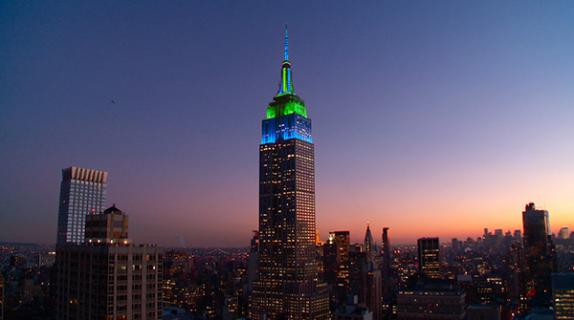A great promo can still get people talking, but a great social campaign can get viewers talking back, letting fans engage with television more deeply than ever before. These five social media marketing efforts from the past year were amazing conversation starters and in some cases, presented ways of interacting with a brand that had never been done before. That’s the great thing about social—its potential as a platform for innovative marketing, as the following campaigns suggest, is virtually limitless.
ESPN/Verizon Social Media-Driven Light Show
The Super Bowl is famed for its on-air commercials during the game, but some of the most innovative marketing around this year’s contest was interactive – especially a social-media/out-of-home campaign staged by Verizon and ESPN. Working with the official light designer of the Empire State Building, Verizon launched a #WhosGonnaWin hashtag campaign on Twitter the week leading up to the February 2 broadcast, asking its 1 million followers football-related questions and using their answers to determine what colors would light up the top of New York’s most iconic skyscraper nightly.
Based on numbers of answers to urgent queries such as “Which team will own the running game” and “Which team has the best fans,” the skyscraper lit up each night with either the Seahawks’ green, blue and silver or the Broncos’ orange, blue and white. Meanwhile, ESPN promoted the Verizon hashtag contest across its own Twitter brands, including @SportsCenter and @ESPNNFL, and revealed which team’s fans won the lighting scheme during the SportsCenter live broadcast. It was a hugely collaborative second screen effort that had real-world ramifications on the most public outdoor space imaginable – social media marketing doesn’t get much better than that.

Shark Week’s Jaw-Dropping Numbers
Last year, an unassuming seal named Snuffy drove the social media buzz around Discovery’s Shark Week to new heights. But the network found a way to not only exceed those totals in 2014 – it smashed them.
Crowning this year’s installment of its annual late-summer programming event the #KingofSummer, Discovery made sure Shark Week lived up to that moniker via a string of innovative marketing efforts and partnerships. Fans could make themselves the King of Summer by inserting their own faces into a Shark Week poster via the Discovery app and website, and live events like FinFest generated huge social buzz. Star Rob Lowe even became an avid Twitter spokesperson for the brand after appearing in a hilarious King of Summer promo. The ratings for Shark Week were fine, but the numbers around social were jaw-dropping: around 13 million people flocked to Facebook to generate more than 21 million Shark Week-related interactions – more than double the 2013 total. Meanwhile, hashtags like #sharkafterdark, #stabjosh and of course, #zombieshark, turned Twitter into a veritable feeding frenzy.
Price is Right – An Old Dog Learns New Tricks
One of the great game show dinosaurs, CBS’ The Price is Right showed you can teach an old dog new tricks with its “Socially Awesome Week” in early June. Events included an Instagram contestant search and a “You Decide the Show” episode on which every element – from prizes to games to host Drew Carey’s wardrobe – was decided by the show’s Twitter base. Even Pinterest got some love, via a sweepstakes for a trip to Hawaii, and for the first time ever, The Price is Right aired fan tweets on-air. 42 seasons in, it was nice to see TV’s longest-running game show connecting with a new era of viewership.

Scandal Stokes the Fires of Social Media Passion
In this ratings-deprived age, the third season finale of ABC’s Scandal in April enjoyed 10.5 million total viewers, earning a 3.4 rating in the adults 18-49 demographic. Though impressive, it was really just the culmination of a carefully stoked social media marketing fire that had already slow-burned the show to 40% end-over-end viewership growth from the season before. While a good chunk of that total derived from a Facebook fan page that swelled to more than 2.7 million likes, the best, most meaningful marketing came from Twitter. There, show creator Shonda Rhimes, star Kerry Washington and other cast and crew had been tweeting during the live broadcasts all season long, communing directly with fans and therefore giving them extra-incentive to tune in for initial episode airings. Their approach to the Twitterverse wasn’t complicated, it just showed how the platform can be used best: delivering consistent, meaningful engagement.
NatGeo Goes Live From Space
The deserved winner of an Interactive Media Emmy Award, National Geographic’s social TV experience for the March broadcast of its Live From Space special was truly other-worldly. As the cameras provided a live look at life onboard the International Space Station, the website LiveFromSpace.com synced with the satellite as it orbited our planet in real time. Visitors to the site could learn more about different countries and cultures around the globe as ISS floated over them, and Instagram users could submit image and video greetings to the astronauts, and ask questions using the hashtag #HelloFromEarth – some of which were answered on-air. The end result was the rare marketing effort that managed to unite viewers all over the world around a broadcast event.

Tags:













































__twocolumncontent.jpg)











